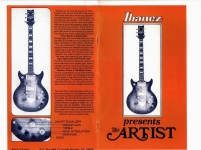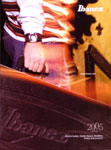Vintage Ibanez Guitar Catalogs - 1971 through 2007

|
Ibanez brand guitars are manufactured at a variety of factories in several countries under contract from the brand's owner, Hoshino Gakki Group. The catalogs scanned and linked below represent output from the year 1971 through the present. During the 1970's and most of the 1980's, Ibanez guitars were made almost exclusively in Japan, and the majority of electric models were made at the Fujigen Gakki manufacturing plant. For a brief history of Ibanez guitars, see below the catalogs. |
A Brief History of Ibanez GuitarsNote: This is a very quick history, and mostly from memory, so take it all with a grain of salt and try to verify what you can from other sources. However, every attempt has been made to provide only verifiable and true information, in an attempt to set the record straight and dispell some modern "myths" about Ibanez model guitars. "Lawsuit" Models, 1971 - 1976As you will note in the earliest catalogs, Ibanez guitars were first "copies" or "reproductions" of guitar models originated by several American guitar manufacturers and manufacturers from other countries. They were not forgeries, as they were never sold with misleading logos or with the intent to deceive. Ibanez models replicated such styles as the Gibson Les Paul, Fender Stratocaster and Telecaster, Rickkenbacker styles, and others. Due to their high quality, Ibanez guitars and those made under other brands, such as Greco and Aria, quickly earned a reputation around the world as quality instruments at a great value. There is a form of urban legend that circulates in the guitar community that has many variations, but usually involves either Gibson or Fender suing Ibanez, Aria, or some other Japanese manufacturer, with the intent to stop that company from manufacturing superior copies. The truth is less glamourous. Only one company ever sued another, and it was Norlin (the owner of the Gibson brand at the time) suing Hoshino (owner of the Ibanez brand) and the suit was focused only on the "open book" headstock shape common to Gibson guitars and replicated on the Ibanez guitars. The suit was brought in 1977, but by then Ibanez had already changed the headstock shape on its copy models, so the suit was settled out of court. No other company was ever sued by any other company. However, this episode has given rise to the term "lawsuit" guitar, which is used to describe any Japanese copy guitar made in the shape of an American manufacturer's model. The Ibanez Golden Age, 1975 - 1981Beginning about 1975, Hoshino began introducing original guitar and bass models to the market. At first, their original designs were subtle variations on the copy models. For example, the "Custom Agent" (model 2405) was basically a Les Paul with a fancy scroll headstock, a fancy pick guard, and, yes, fancy inlays on the neck and body. The Professional model 2671 was a Les Paul with a "vined" neck and a fancy headstock. But soon, the overall shapes of the guitars changed, and models known as the "Weir" (after Bob Weir of the Grateful Dead), "Artist" and "Musician" were introduced. By 1978, Hoshino had ceased production of all of its copy models and was truly producing 100% original designs. These guitars are not just beautiful, but are some of the best crafted guitars of all time, by any manufacturer, and represent the pinacle of guitar-making skill and quality. The Metal Years and BeyondNote: For additional information and history on Ibanez guitars, please check Wikipedia. For a great overall resource for Ibanez guitar questions, check out the Ibanez Collectors World website. The ICW is a gathering of Ibanez collectors who relish in the challenge of not just collecting Ibanez guitars, but of identifying old models, dating guitars by serial numbers, and generally watching the vintage guitar marketplace to understand how interest in Ibanez guitars is evolving. SourcesOriginal source file location: http://www.ibanez.ru/info/index.php?catalog Here's are links to more catalogs. http://www.ibanezrules.com/catalogs/index.htm http://www.ibanez-vintage-page.de/ Downloadable PDF's http://tinyurl.com/36d54e links to http://musik-meinl.t3-kundenserver.de... ... ... DISCLAIMER: Hoshino owns the copyright to all of the catalogs scanned in here. This website has NO RELATIONSHIP with the Hoshino Gakki Group and makes no claims to ownership of the linked scans. These catalog scans are provided solely for personal academic/research purposes, so that collectors and others who own one or more of these fantastic guitars can properly identify the model and year of manufacture. |








































































